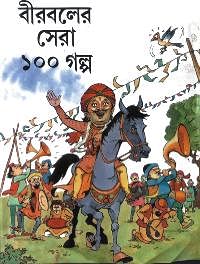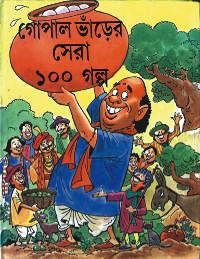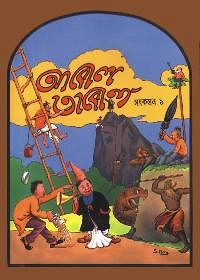Bnagla
Fiction
For
The Young
By
Nusrat
BANGLA
juvenile literature is very rich, ranging from fairy tales to teenage
classics to science fictions to ghost stories.
 First
let's take a look at children's books. Princes and princesses, monsters
and demons, ghosts and ghouls, fairies and imps, witches and wizards…and
all those characters which live in a child's imaginary world are depicted
vividly in the children's fairy tales. For a long time Bengali writers
have been writing juvenile stories about such imaginary characters,
which have successfully captured the fascination of young children.
Nowadays, though the fairy tales for young children are being influenced
by Disney classics, the normal Bangla fairy tale trend has not vanished
completely. The usual stories about a princess being kidnapped by
a hideous monster and the prince speeding across a vast "tepantorer
maath" on a "ponkhiraj" to rescue her, are still enjoyed
by the youngsters. Many of the fairy tales are passed down the generations.
These were usually stories that a grandmother would tell her wide
eyed, open-mouthed grandchildren who would not rest until the prince
rescued the princess, got married and "lived happily ever after".
Such stories were later on collected to form fairy tale books. One
of the most famous fairy tale collection is undoubtedly the "Thakur-maar
Jhuli".
First
let's take a look at children's books. Princes and princesses, monsters
and demons, ghosts and ghouls, fairies and imps, witches and wizards…and
all those characters which live in a child's imaginary world are depicted
vividly in the children's fairy tales. For a long time Bengali writers
have been writing juvenile stories about such imaginary characters,
which have successfully captured the fascination of young children.
Nowadays, though the fairy tales for young children are being influenced
by Disney classics, the normal Bangla fairy tale trend has not vanished
completely. The usual stories about a princess being kidnapped by
a hideous monster and the prince speeding across a vast "tepantorer
maath" on a "ponkhiraj" to rescue her, are still enjoyed
by the youngsters. Many of the fairy tales are passed down the generations.
These were usually stories that a grandmother would tell her wide
eyed, open-mouthed grandchildren who would not rest until the prince
rescued the princess, got married and "lived happily ever after".
Such stories were later on collected to form fairy tale books. One
of the most famous fairy tale collection is undoubtedly the "Thakur-maar
Jhuli".
Apart from these
compilations, many famous writers like Upendrokishore Roy Choudhury
had written children's stories, which are still loved by the children.
No matter how much popular the English fairy tales are nowadays, Bangla
fairy tales have always been a part of growing up for nearly every
Bengali child. I am sure that there is hardly anyone who has not grown
up listening to fairy tales like "Panta Burir Golpo". Another
well-loved writer who wrote stories for young children is Shukumar
Roy. He had an amazing ability to write such stories that set his
readers laughing their hearts out. All his writings are so humorous
and jocular that they can change any frown to a smile in no time.
And of course his stories are loved by children of all ages and adults
alike. One of Shukumar Roy's most famous collections, "Shamagra
Shishushahitya" consists of a vast collection of short stories
and poems for young children. Shibram Chakrabarti is another master
storyteller who, through his unique style of writing, has conquered
the hearts of all the Bengali children.
Now coming to
teenage classics. Like the olden days, teenage classics mainly comprised
of mystery and adventure-based stories. Young minds are always brimming
with enthusiasm and vivacity and they always look forward to an adventurous
life. Therefore such adventure stories highly captivate the fascination
of teenagers. Many Bengali writers have written mystery stories for
teenage group. Books by such writers as Kazi Anwar Hossain, Niharranjan
Gupta and Satyajit Roy were the craze of the time. Kazi Anwar Hossain
wrote a series of detective books such as "Kuashaa", "Tin
Goyenda" etc. He also wrote a series of spy thrillers with the
popular Masud Rana" as the main character.
Niharranjan Gupta's
was a very famous writer who also wrote detective stories for children.
He created the Bengali Sherlock Holmes -- "Kiritee Rai".
This gallant crime-solver is perhaps one of his most famous characters.
Another famous (or rather infamous!) character created by Niharranjan
Gupta was "Kalo Bhramar", a notorious, dangerous and intelligent
criminal. Most of the plots of Niharranjan Gupta's stories revolve
around atrocious crimes committed by "Kalo Bhramar" and
his gang and Kiritee Rai's investigations to track them down and solve
the mystery. Many of these thrilling stories are collected in different
books, which are immensely enjoyed by the young population. "Kiritee
Omnibus" and "Kalo Bhramar"
are a few to name.
Talking
about mystery stories, the name of renowned writer and playwright
Satyajit Roy comes to  mind.
Satyajit Roy wrote many detective stories with his famous crime-solver
"Feluda" as the main character. These detective stories
are so popular that it was even made into a television programme.
Another of Satyajit Roy's creations was a crazy professor called Professor
Shonku. Satyajit Roy has written quite a few books on the thrilling
discoveries of this professor. Besides all these, Satyajit Roy has
written a number of short stories for children. These hilarious and
amusing stories have been compiled in two volumes of "Shera Satyajit".
Satyajit Roy was also a playwright. He wrote many plays, out of which
some have been made into movies. Some of his famous movies were "Gopi
Gayne Bagha Bayne", "Hirok Rajar Deshe" etc.
mind.
Satyajit Roy wrote many detective stories with his famous crime-solver
"Feluda" as the main character. These detective stories
are so popular that it was even made into a television programme.
Another of Satyajit Roy's creations was a crazy professor called Professor
Shonku. Satyajit Roy has written quite a few books on the thrilling
discoveries of this professor. Besides all these, Satyajit Roy has
written a number of short stories for children. These hilarious and
amusing stories have been compiled in two volumes of "Shera Satyajit".
Satyajit Roy was also a playwright. He wrote many plays, out of which
some have been made into movies. Some of his famous movies were "Gopi
Gayne Bagha Bayne", "Hirok Rajar Deshe" etc.
The children today
still enjoy Satyajit Roy's detective stories very much. To keep up
this trend more writers are coming up with detective stories for children.
Writers like Sharier Kabir, Rakib Hassan etc. have written many adventure
and detective stories for children. One of the most famous and acknowledged
adventure storywriters is none other than Dr. Muhammad Zafar Iqbal.
He wrote numerous adventure stories, which captivated a huge population
of young readers. His famous adventure stories were all collected
in two volumes of "Kishore Upannyash Shamagra". The characters
of these stories are almost always little boys and girls who get entangled
in some adventure and unravel the mystery. One of the reasons that
these stories are so much popular among youngsters is that, there
is a great deal of humour involved in each of the stories. In each
story the writer portrays the young characters in a very realistic
way, by describing some of their mischievous pranks. He has described
really well, how a few young boys climbed over walls to pick mangoes
from someone else's tree, and how young girls dressed up as ghosts
and scared away some people. Very typical of young children! Besides
these, Muhammad Zafar Iqbal also writes science fictions, which are
even more popular than adventure books. His science fictions are totally
out of the world! They take the readers into a totally different world
with robots, aliens, spaceships and other extraterrestrial gadgets
and creatures. Most of the stories are set a few hundred years in
the future. These stories are enjoyed even more because they describe
things that people have never seen or heard of. These stories give
young children the freedom to extend their imagination.
 Another
vast field of Bengali literature is horror stories. These types of
stories are very uncommon in other parts of the world. The horror
stories range from light ones for young children to spine-tingling
thrillers for the teens. The ones written for young children are completely
unique in our subcontinent. The most popular ghosts that scare little
children to death are the "Mamdo Bhoot", who usually lives
on the top of a Banyan tree, the "Petni", who wears a white
sari and haunts old houses, or the "Daini buri", who kidnaps
young children and throws them into her hot cauldron. Mothers take
aid of these 'scary'(!) characters to put their naughty children to
sleep and the poor children quickly shut their eyes thinking of the
circumstances if they ever fell into the hands of these abominable
creatures. The horror stories for teenagers are usually much more
frightening. The stories revolve around incidents in crematoriums,
haunted houses, dense thickets and other terrifying places. Other
stories are about resurrection of the dead, free evil spirits, possessed
people and ghastly animals like werewolves. Writers like Shirshendu
Mukhapadhay, Mahashweta Devi, Sunil Gangapadhay, Syed Mustafa Siraj
and many others wrote numerous horror stories, which provide hair-rising,
spine-tingling entertainment for hours.
Another
vast field of Bengali literature is horror stories. These types of
stories are very uncommon in other parts of the world. The horror
stories range from light ones for young children to spine-tingling
thrillers for the teens. The ones written for young children are completely
unique in our subcontinent. The most popular ghosts that scare little
children to death are the "Mamdo Bhoot", who usually lives
on the top of a Banyan tree, the "Petni", who wears a white
sari and haunts old houses, or the "Daini buri", who kidnaps
young children and throws them into her hot cauldron. Mothers take
aid of these 'scary'(!) characters to put their naughty children to
sleep and the poor children quickly shut their eyes thinking of the
circumstances if they ever fell into the hands of these abominable
creatures. The horror stories for teenagers are usually much more
frightening. The stories revolve around incidents in crematoriums,
haunted houses, dense thickets and other terrifying places. Other
stories are about resurrection of the dead, free evil spirits, possessed
people and ghastly animals like werewolves. Writers like Shirshendu
Mukhapadhay, Mahashweta Devi, Sunil Gangapadhay, Syed Mustafa Siraj
and many others wrote numerous horror stories, which provide hair-rising,
spine-tingling entertainment for hours.
Many of the young
people of this generation of our country mainly read English stories
and classics. The glory of the rich Bengali juvenile literature is
gradually fading. Though stories for very young children are still
popular, the Bengali teenage classics are being subdued by English
classics. Unfortunately the well-loved Bangla stories of the past
are rarely available in the market. If these olden books were reprinted,
the children could once again get the chance to know our age-old tales.
It would revive the heritage of the Bengali juvenile literature.
